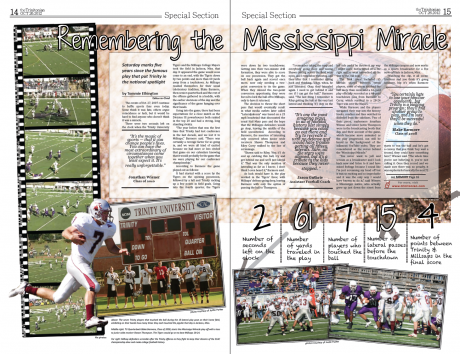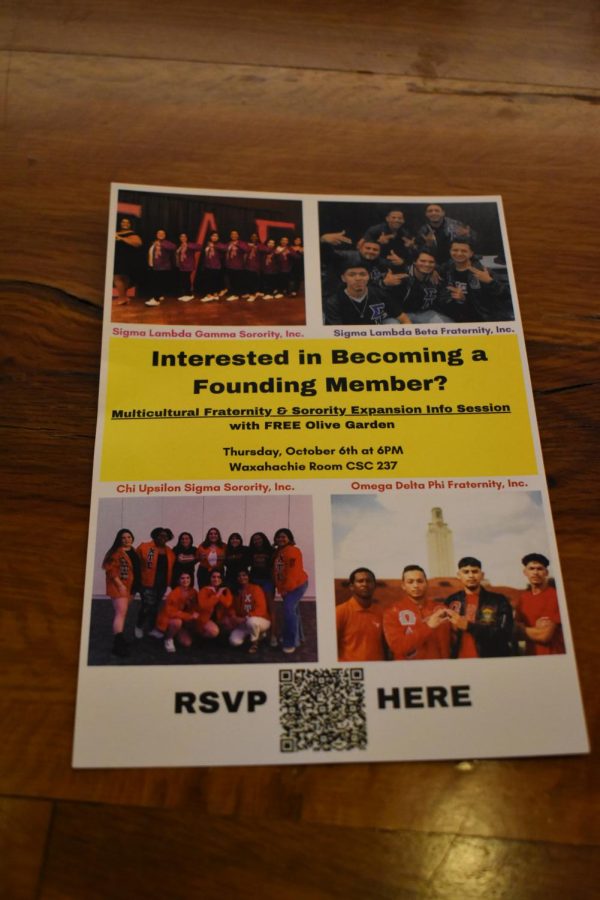http://vimeo.com/52196327
The Mississippi Miracle from Tiger TV on Vimeo.
The events of Oct. 27, 2007 continue to baffle sports fans even today. Some think it was fate, others argue coincidence or luck, but it would be hard to find anyone who doesn’t think it was a miracle.
There were two seconds left on the clock when the Trinity University Tigers and the Millsaps College Majors took the field in Jackson, Miss. that day. It appeared the game would soon come to an end, with the Tigers down by two points and more than 60 yards away from a touchdown. As Millsaps readied themselves for their usual celebratory tradition, Blake Barmore, then-senior quarterback and the rest of the offense gathered in a huddle, with the earlier decisions of the day and the significance of the game hanging over their heads.
Going into the game, there had been expectations for a close match as the Division III powerhouses both ranked in the top 20 and had a strong, long standing rivalry.
“The year before that was the first time that Trinity had lost conference in the last decade, and we lost it to Millsaps,” Barmore said. “There was certainly a revenge factor for us going in, and we were all kind of excited because we had more or less circled that game on our calendars knowing that it would probably be the game that we were playing for our conference championship.”
According to Barmore the game played out as follows:
It had started with a score by the Tigers on the opening possession, followed by a lull and Trinity racking up a few points in field goals. Going into the fourth quarter, the Tigers were down by two touchdowns. Getting into their two-minute drill formation, they were able to score on one possession. They got the ball back again and scored once more, now only needing a two-point conversion to tie the game. When they missed the two-point conversion opportunity, they were forced to kick the ball off to Millsaps, only to have it recovered.
The decision to throw the short pass that would eventually result in what media outlets later called “Lateralpalooza” was based on a 25 mph headwind that discounted the usual Hail Mary pass and the hope that the Millsapps defenders would go deep, leaving the middle of the field uncontested. According to Barmore, the mention of lateraling only occurred when junior wide receivers Shawn Thompson and Riley Curry walked to the line of scrimmage.
“Shawn said to Riley, “˜Hey, if I do end up catching this ball, try and get behind me and we’ll just lateral it.’ That was the only mention of lateraling as far as I know; I don’t think I even heard it,” Barmore said.
As luck would have it, the play worked in the Tigers’ favor, with Millsaps’ defense going deep, leaving Barmore with only the option of passing the ball to Thompson.
“I remember taking the snap and everybody going deep and seeing Shawn cutting across the field wide open, and I remember throwing, and then after that I remember sitting back and thinking, “Okay, whoa, he just lateraled. Okay, they lateraled again. I need to get behind it and see if I can get the ball,'” Barmore said. “The last thing I remember is Riley getting the ball at the very last lateral and thinking “˜If I stay on the left side and if he throws it my way I might score’, but he jetted off to the right and he went untouched all the way to the end zone.”
The final count included 15 laterals shared between seven players, some of whom touched the ball more than once, and a 61-yard play officially recorded as a 44-yard touchdown pass from Barmore to Curry, which resulted in a 28-24 Tiger win over the Majors.
While Barmore and the players navigated their way into the history books, coaches and fans watched in disbelief from the sidelines. Two of their peers, sophomore Jonathan Wiener and senior Justin Thompson were in the broadcasting booth that day, and their account of the game, which became more animated as the play progressed, can still be heard in the background of the infamous YouTube video. They are remembered as the voices behind the “Mississippi Miracle.”
“You never want to yell and scream as a broadcaster and I look back now and listen to it and have mixed feelings because I sound like I’m just screaming my head off but it was so exciting and so improbable and it was the only way I would have known to do it,” said Wiener, a Mississippi native, who actually grew up just down the street from the Millsaps campus and now works as a sports broadcaster for a Fox news affiliate in Jackson, Miss.
“Watching the clip, it all seems frivolous and you think it’s going nowhere, but it’s when Barmore starts to run the ball and he’s got a convoy that you think “˜hey wait a second, they could have something here’,” Wiener said. “The whole time you’re not believing it, you’re just calling it. Once they scored and we made sure there was no penalty, it was euphoria for basically the next 72 hours. We were just trying to grasp what had happened. It was so hard to describe and so exciting. It was pandemonium “” in the best kind of way.”
Judging by the media frenzy that followed, sports fans around the country agreed with Wiener. That evening, a clip of the game was played on ESPN’s popular show, “SportsCenter,” and articles recounting the miraculous moment were published in The New York Times, USA Today and Time magazine. Attention in the form of awards soon followed.
In the Dec. 24, 2007 issue, Time magazine declared the game the “#1 Top Sports Moment of 2007,” and the “Miracle 15-Lateral Play” earned the Tigers a $100,000 general scholarship and the title of “The Pontiac Game Changing Performance of the Year,” an accolade that, up until that point, had never before been awarded beyond the NCAA Bowl Subdivision.
But the players and assistant coach Jason Guthrie agree that one of the most exciting moments came with their nomination in the category of “Best Play” at the 2008 ESPY awards, ESPN’s annual sports award ceremony.
“When we went out to the ESPYs, a lot of people including celebrities like Jerry Rice””whether they knew about it or not, somebody told them to know about it””they went up and said great things to the kids,” Guthrie said. “That’s something you can’t take away. That’s a memory that they’ll have forever.”
While the Tigers eventually lost to a Super Bowl play, the moment remains monumental.
“Regardless of the level of the play and all the criticism it got, it’s one the most amazing plays in all of football history just simply because you could go out there and try to recreate it with no defense and would have trouble getting all fifteen laterals,” Guthrie said. “Sure, all the stars were aligned, but it’s a tribute to the kids because they never stopped. The play was 62 seconds long when the average football play lasts seven seconds, and a long play lasts for only 10-12 seconds. So you’re talking about a 55-second increase in the average play and for those kids to keep going and keep fighting, I mean “¦ that’s amazing.”
Five years and millions of YouTube views later, people still talk about the play, with ESPN even running a special commemorative series on the front page of their website last year.
“It’s the magic of sports “” that it can change people’s lives,” Wiener said. “You can have the most extraordinary of circumstances come together when you least expect it. It’s really unforgettable.”
Along with the anniversary, this year also marks the end of the intense rivalry between Trinity and Millsaps due to the dissolution of the Southern Collegiate Athletic Conference (SCAC). While Guthrie says Trinity will likely continue to play Millsaps because they are good competition for the Tigers, the game will not contribute to any sort of conference rankings.
“You kind of hate to see that history go away,” Barmore said. “You certainly hate to lose your familiar opponents and the automatic bid that goes along with playing in the SCAC conference, but Trinity is a building program; they’ll find another group to play, and I’m sure they’ll be successful when they do.”
The Tiger football team now looks to the future, both immediate and long-term. On Saturday, they take Millsaps on at home, beginning at 1:30 p.m.
As the players suit up and fans pack the stands, Guthrie will be getting ready to coach the Tigers with memories of the past, but a focus on the upcoming battle.
“I think the one thing that game is a testament to is you never know what’s going to happen and you should never pack your bags until it’s absolutely over and you know you don’t have another opportunity. As long as you’re within a score with any time remaining on the clock, you’ve got to do something to try and make it happen,” Guthrie said. “We had two seconds left on the clock, and had everything not fallen into place, it may not have happened. But it did, and the kids were ready to do something. They wanted to win the game. I think that kind of fight says a lot. I know it was five years ago, but that still holds true every week; we’re going to keep fighting until the last whistle blows.”
For an interview with Millsaps coach Aaron Pelch, click here.

Corrected Nov. 4, 2012
This article initially stated that Millsaps returned, rather than recovered, Trinity’s onside kick following the attempted two-point conversion.






Bob • Oct 26, 2012 at 4:41 pm
Actually, after missing the two-point conversion, Trinity tried an onside kick that Millsaps recovered, not returned.
And had the Millsaps QB not inexplicably done this slow jog backwards on the final fourth down play, he could have easily run out the clock. That was a major coaching failure from then-Millsaps head coach Mike DuBose.
Thanks for the detailed coverage. It was a great game and a tribute to those young student-athletes representing Trinity who refused to give up.